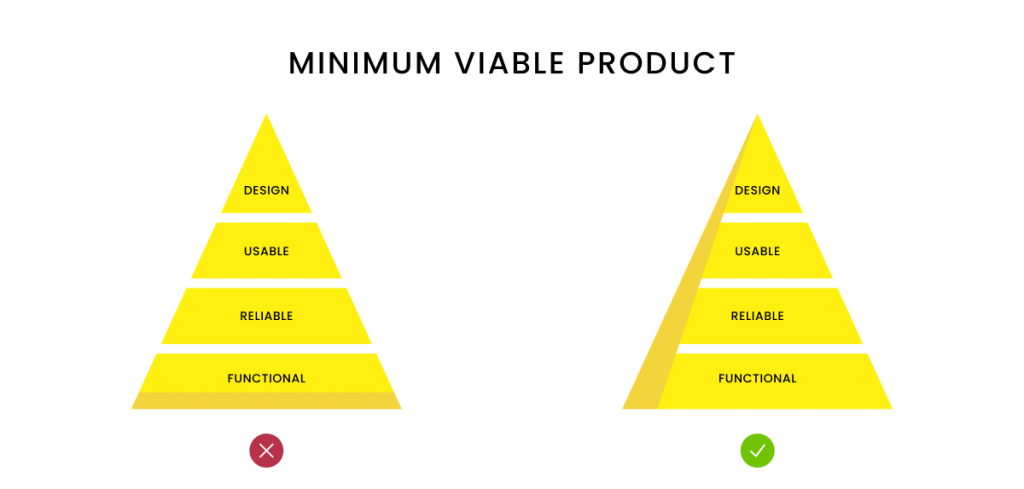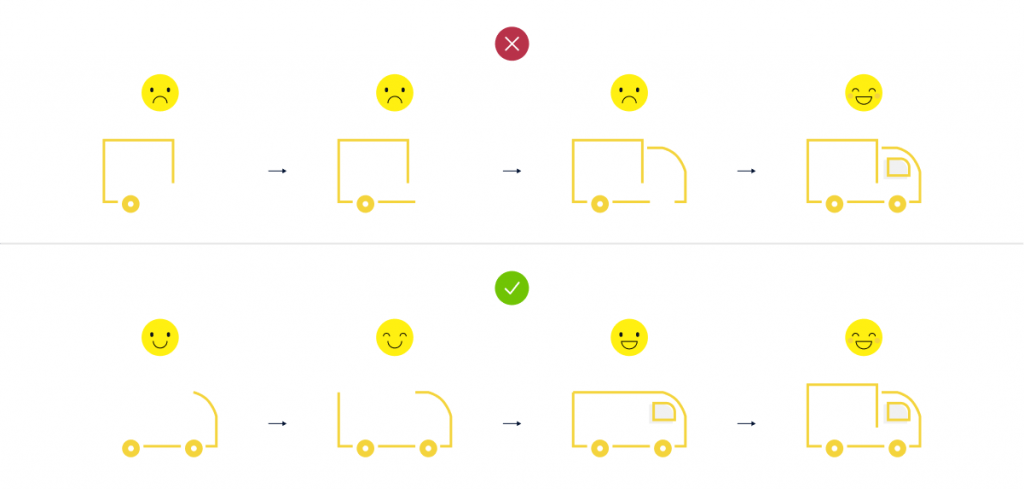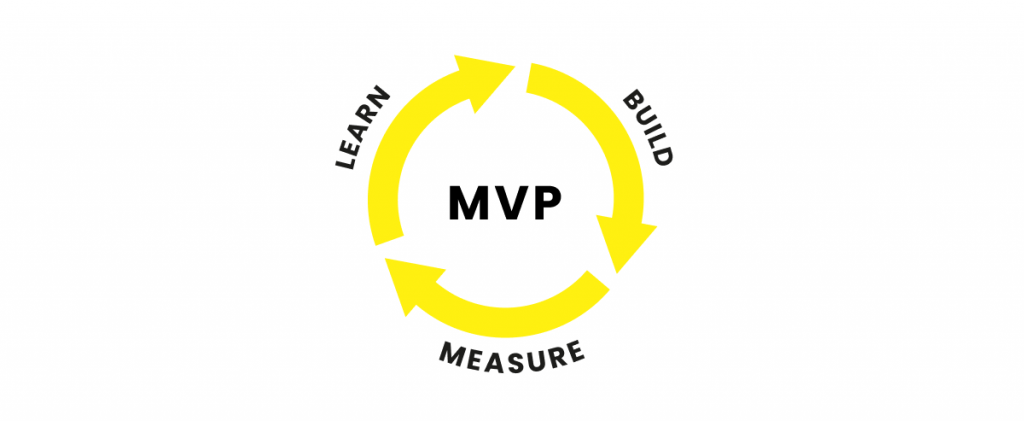MVP is the great way for startups to introduce their new products to the market. How can developing an efficient MPV process bring real benefits to your business? In our guide, we’ll cover everything you need to know about Minimum Viable Product. We’ll also give you tips on how to take the right approach that will help you build an MVP successfully.
Table of Contents
Things you will learn
If you need an introduction to the concept of a Minimum Viable Product and want to get to know its perks and pitfalls, you’ve come to the right place. In this guide, you’ll find all the crucial information concerning MVP development and a bunch of useful tips on how to successfully build an MVP of your product. So, let’s discover:
- What is a Minimum Viable Product?
- The benefits of building an MVP
- The pitfalls of launching an MVP
- How to plan the successful launch of MVP?
What is an MVP?
An MVP is the acronym for a Minimum Viable Product, and it refers to a very basic version of your product (e.g. a mobile application). Even though a product doesn’t have any extra features yet, it has got fully developed main functionality. Containing all must-have features the product already fulfills its value proposition.

As you see in the graphic above, MVP is about building various features across the whole development process rather than one layer at a time. It means you don’t have to finish one segment of features and then proceed to the next one. The focus is put more on functionality than on design. However, a good MVP needs to involve a little bit of every aspect of product development in order to show its functionality.
Why do you need an MVP?
As far as your product works properly, there’s no point in postponing the launch. Some experts say that waiting to polish up all the details of your application is of no use. Instead of creating a final perfect version, you can pre-launch the basic product on the market, and get much more benefits out of it. Developing MVP may become the key to the success of your product on the market.
MVP development enables:
- faster product launching,
- attracting first users,
- fitting to the market’s expectations in advance,
- getting valuable feedback from early users (that gives you an opportunity to adapt your product to customers’ expectations much faster).
In the reality of software development, the MVP process is really important. It allows delivering a new product with main functionalities to the target audience. In this way, people can see how it works in practice. MVP development is also a great way to show your potential clients or investors the core value of your product.
What’s the difference between MVP, PoC, and a prototype?
What is an MVP, and what is not? There are a lot of definitions of an MVP, but some of them are not clear enough. As a result, we often confuse MVP with a prototype or a Proof of Concept, which is clearly wrong. These terms are completely different, so let’s explain them:
- PoC, which stands for a Proof of Concept, is a method used while developing software to show clients basic assumptions of the product. PoC is the way to visualize the idea behind the product and present it in the nice form of a clickable mockup.
- A prototype is the demonstration of a product that doesn’t exist yet. Its aim is to show what it may look like in the future. While building a prototype of an application or website it’s necessary to focus on the design and UI (User Interface) aspects. Prototypes are needed especially when you develop complex projects – it’s rarely used for simple apps.
So, what an MVP actually is?
First of all, an MVP is not a product. It is rather a process. In this engaging process, you will need feedback from the so-called early adopters. They are the very first users of your product who will share suggestions concerning the value of your product. Based on this, you can make iterations, pick up and fix bugs, and develop new features.
Don’t get confused and remember that MVP is NOT:
- A prototype,
- POC,
- A demo,
- A sample of a single product phase,
- An unfinished product without fully developed basic functionality.
How does the MVP development process work?
Here is a simple graphic explanation that illustrates what an MVP really is. Let’s imagine that your final product is a truck, like the one in the picture below. In order to build a minimum viable product, you don’t have to take up the bottom-up approach and construct your truck piece by piece to get a final product.

If you want to develop a really good MVP you have to achieve a ready-to-use product without going too much into details. Take a look at the second row in the illustration. Here, the simple scooter suddenly turns into a big truck. That’s how the MVP process works. First, you should pay attention to creating a product with minimum functionality. Then, in the next steps, you can add extra features. In this way, the next version of your MVP, the truck can turn into a glider or a big plane.
Pitfalls of launching an MVP
Building a Minimum Viable Product is not an easy task. Sometimes it involves some risks, as there are many things that can just go wrong. We’ve listed some common pitfalls when developing the MVP process:
- Too much focus on delivering the final product
Some project owners believe that the MVP should be flawless and bug-free. However, that’s not what MVP is about. The most important rule is to deliver a basic product that’s functional and carries some value to the users.
- Skipping research phase

As Reid Hoffman wrote on his Twitter – you shouldn’t delay the pre-launch of your product. Of course, you may take up the rapid release approach, however, it’s not the solution that works in every case. Sometimes rapidity can become the pitfall of developing MVP, and result in skipping the research stage, which is so crucial before launching any product.
- Neglecting feedback
Once the MVP is launched, initial feedback of the very first users comes in really handy. It gives the company an opportunity to quickly fix the bugs or introduce new wanted features. It is much easier to make changes at the beginning than after releasing the final version of the product.
- Hiring inexperienced teams
Developing an MVP with teams without bigger experience may result in many bad decisions. The most common mistakes include overestimating abilities or the other way round – underestimating the effort that is needed to create a successful MVP. This leads to working in a rush to complete the final product or going beyond the budget devoted to the project.

Take a closer look at:
How badly chosen technology and the lack of MVP can kill a project?
How to plan the successful launch of MVP in 3 steps?
There are a few things that we believe every startup needs to do before launching MVP. As you can see in the schema below, the complete MVP cycle includes 3 aspects that overlap with each other. MVP is about: building, measuring, and learning.

Here are the actions that you can take at every stage of developing MVP:
- Verify market demand
You may believe that your idea is great, but what about your target audience? Exposing MVP to potential customers will help you adjust it to their expectations. Conducting good research and collecting feedback is the key to successfully launching your product on the market.
- Test UX efficiency
UX (user experience) is an intrinsic part of every great product. When you release an MVP, you should take your product’s UX to the highest level. Testing and building used interchangeably will enable gradual upgrading of your product.
- Educate
MVP gives people time to get familiarized with your product. In this way, you educate them about your product and brand. The ability to give feedback that makes an impact on your product generates interest and engagement. Thus, releasing MVP is a better solution than launching a revolutionary product that doesn’t quite fit into users’ expectations.
Take the right Approach and build your MVP with Success
In this article, you’ve found out that MVP can foster the early launch of your product and bring your company many benefits. Now, you also know what are the pitfalls of developing the MVP process. We hope our tips will come in handy and help you in scaling up your business!
If you have any questions on releasing MVP or any other IT issue, contact our experienced teams, who are specialists in developing projects from scratch.
